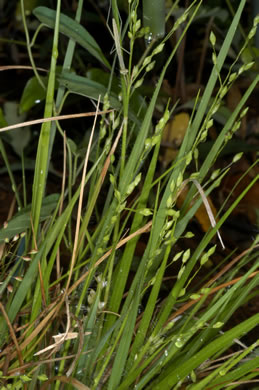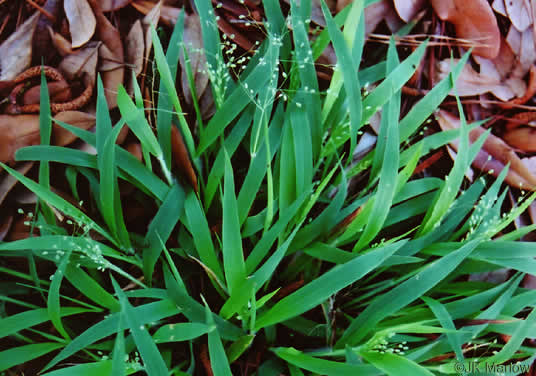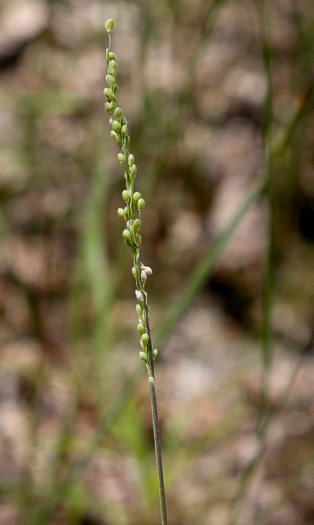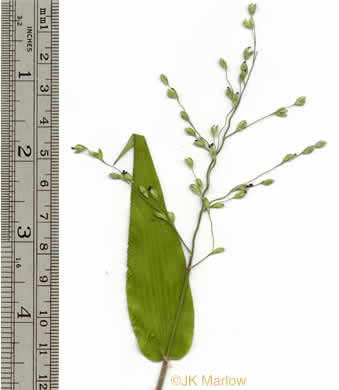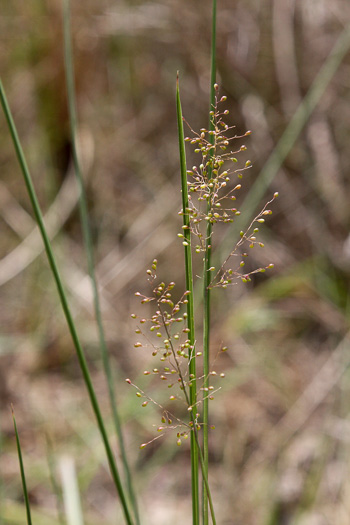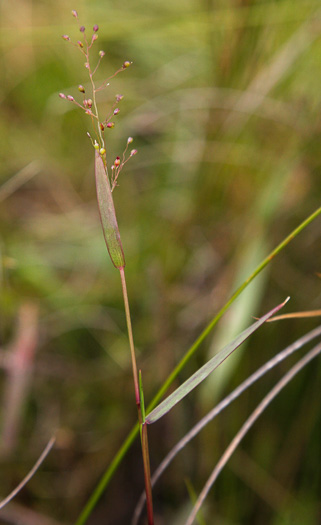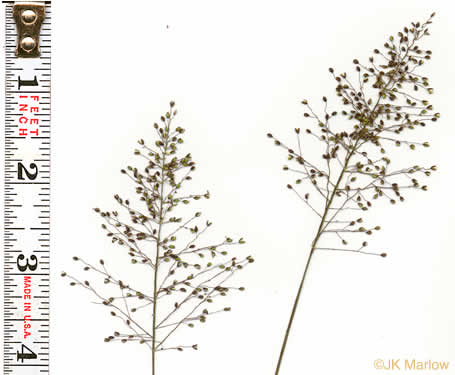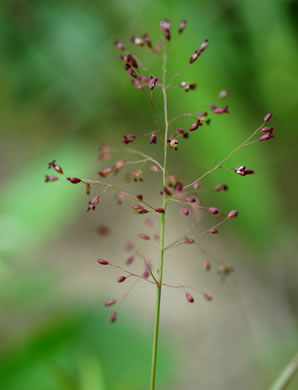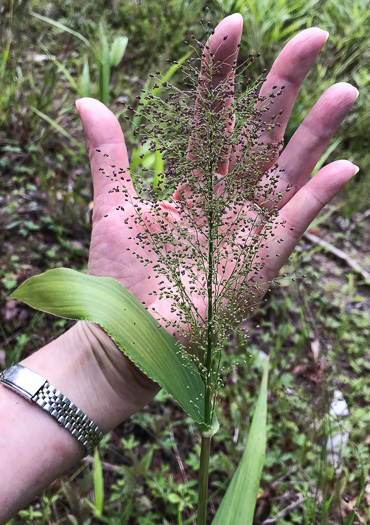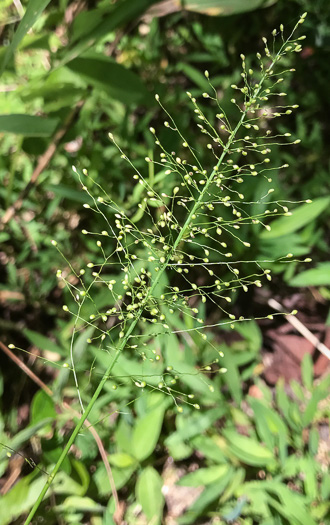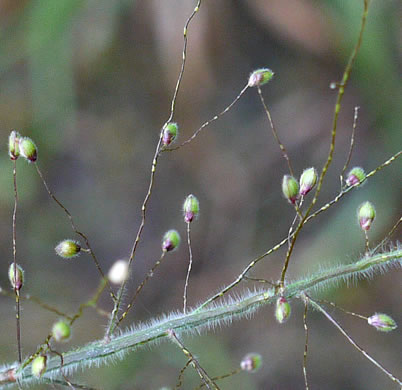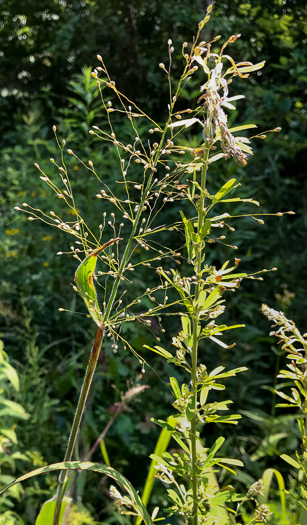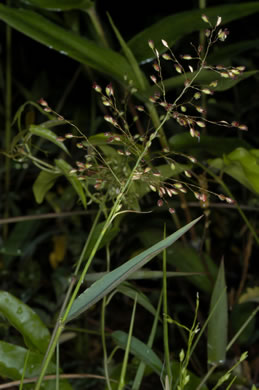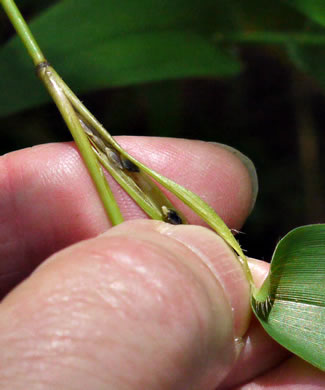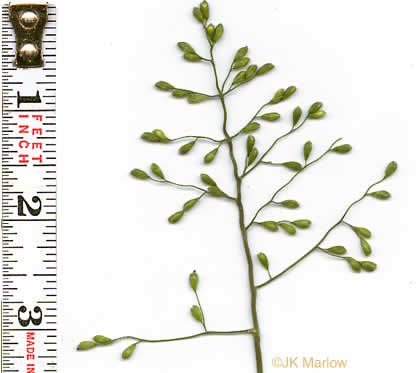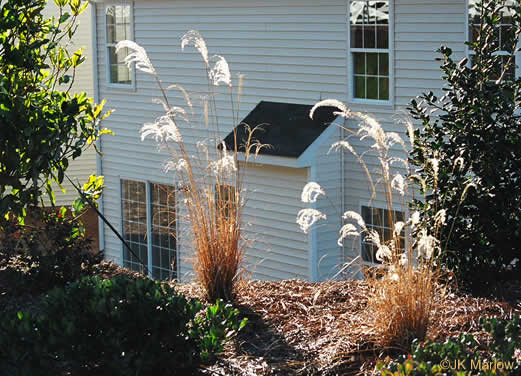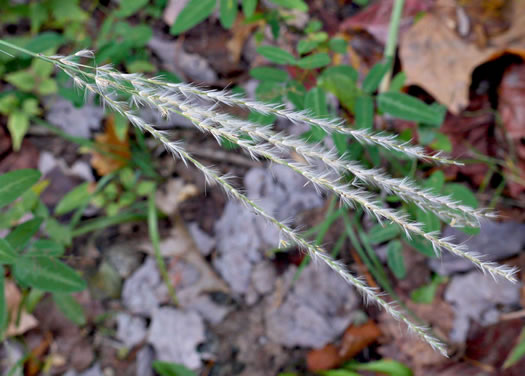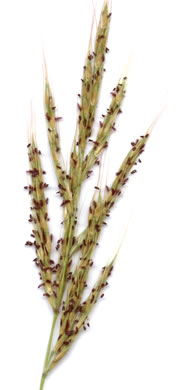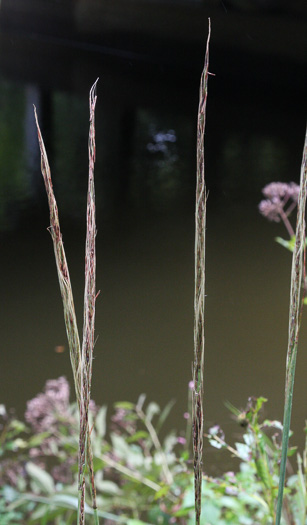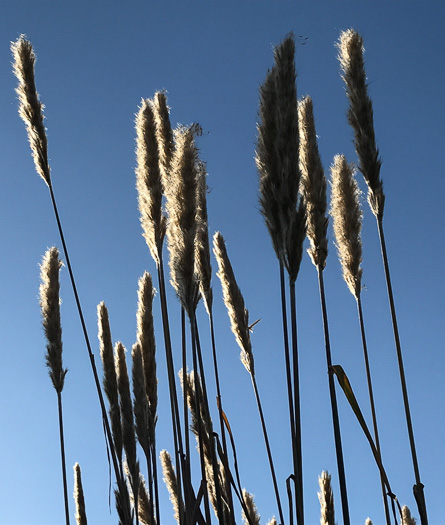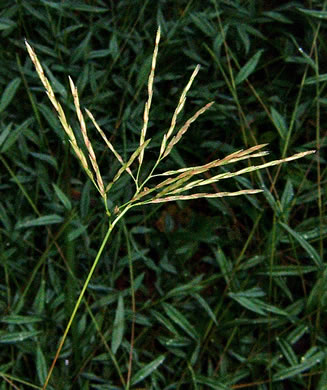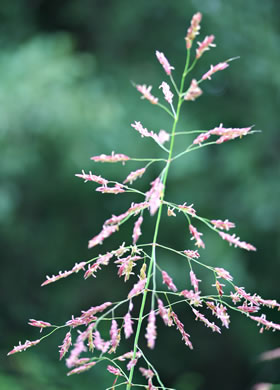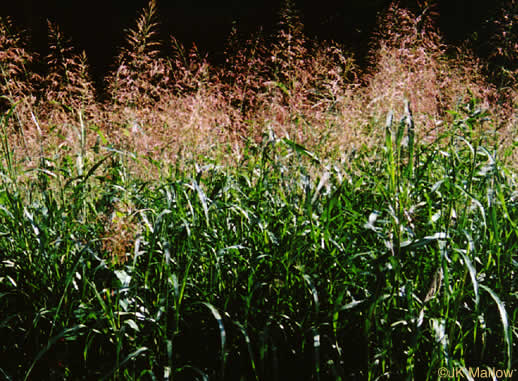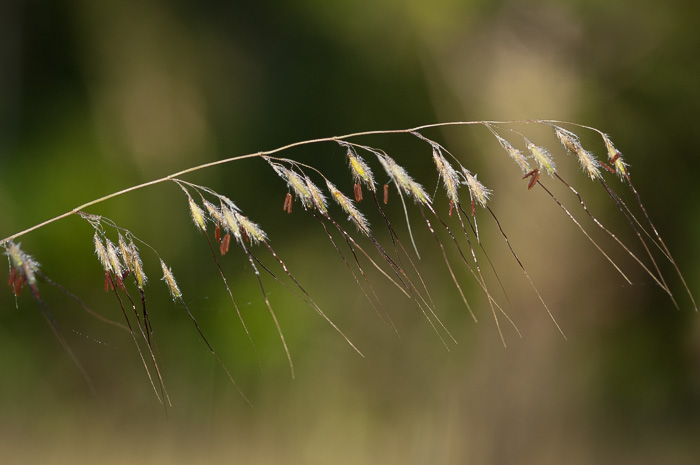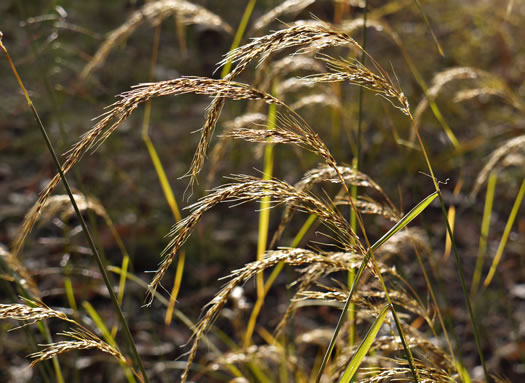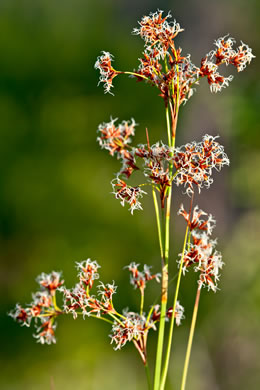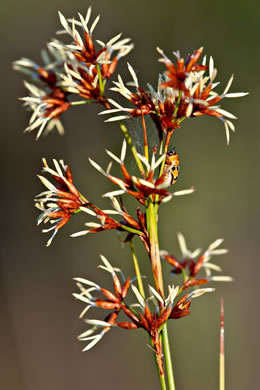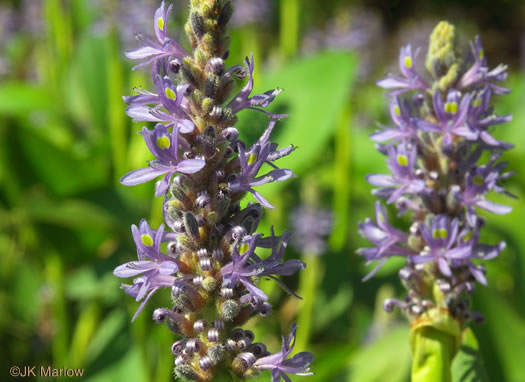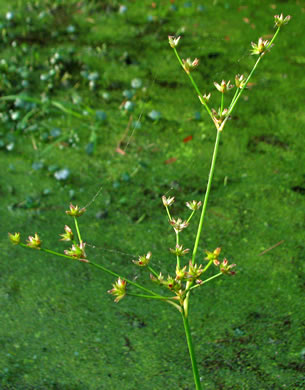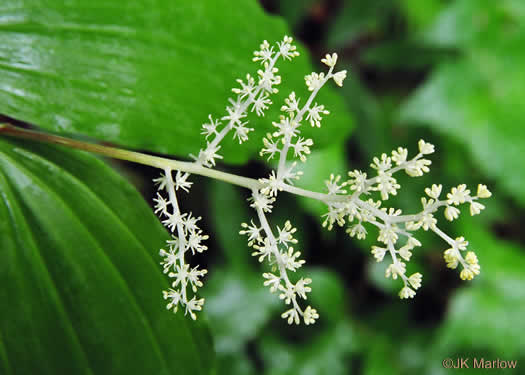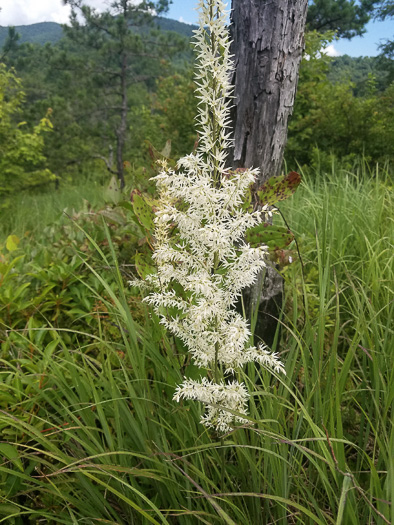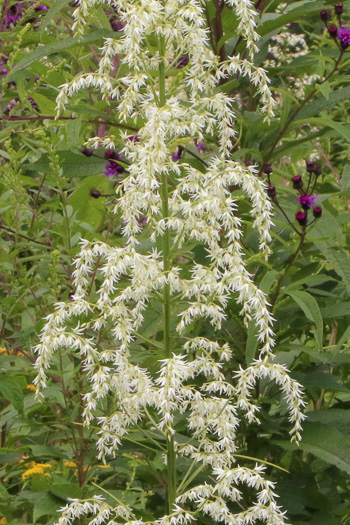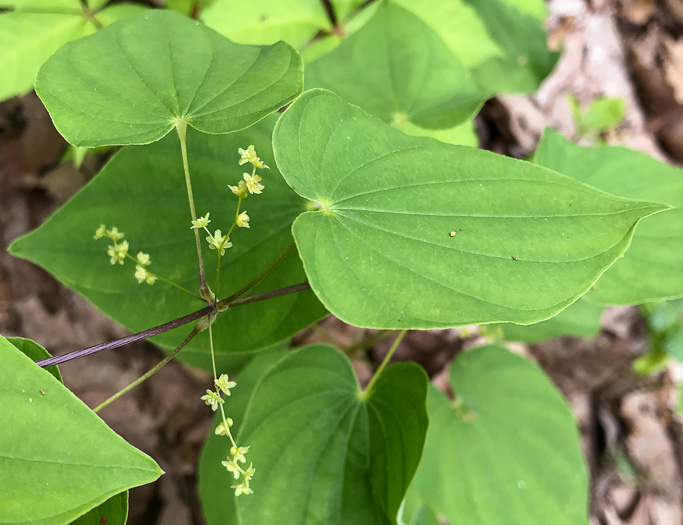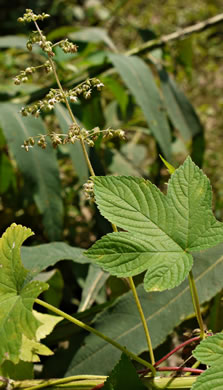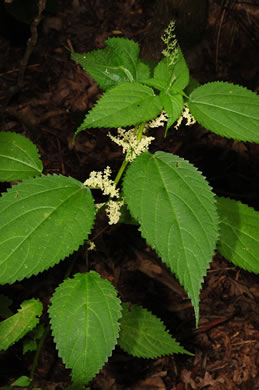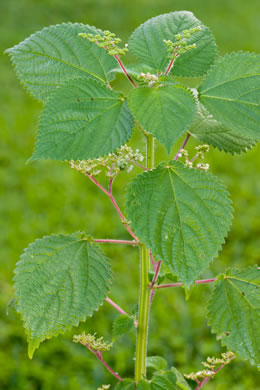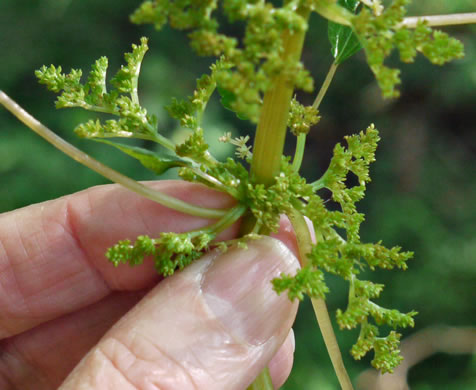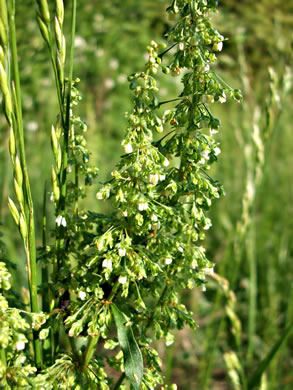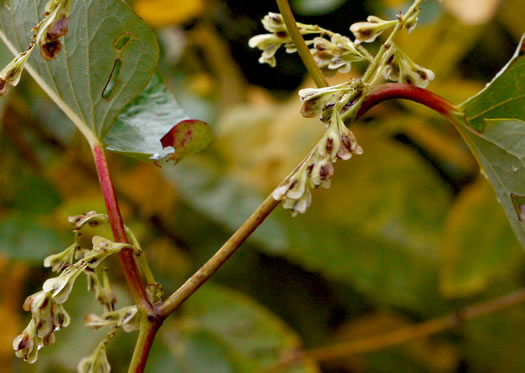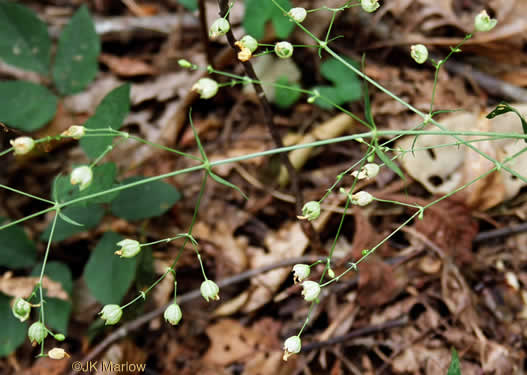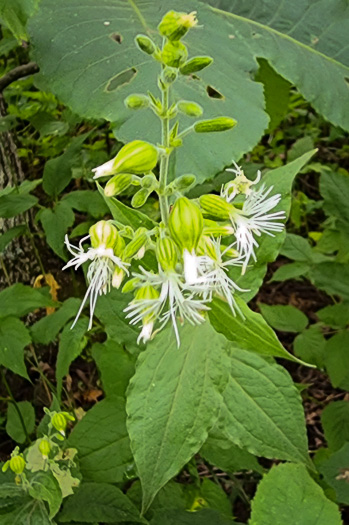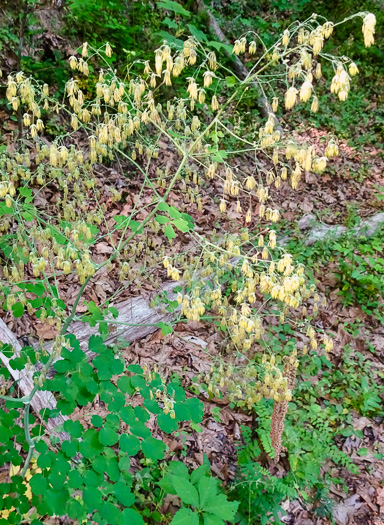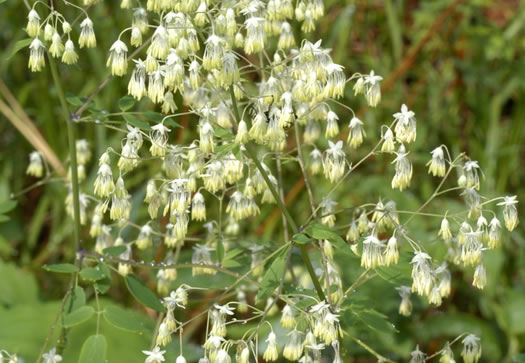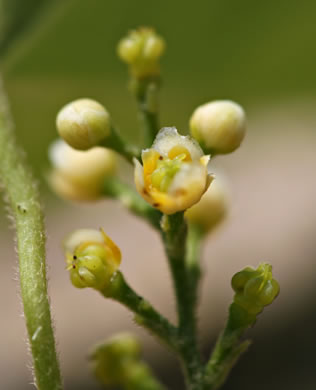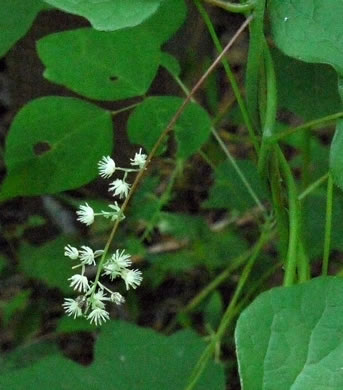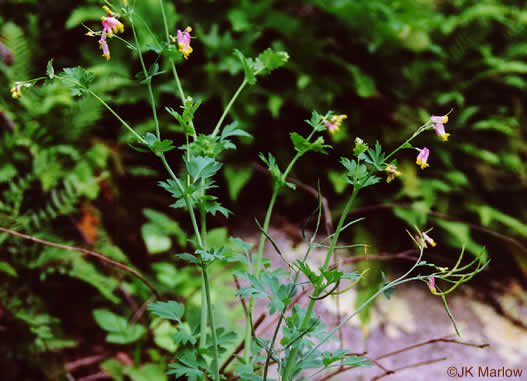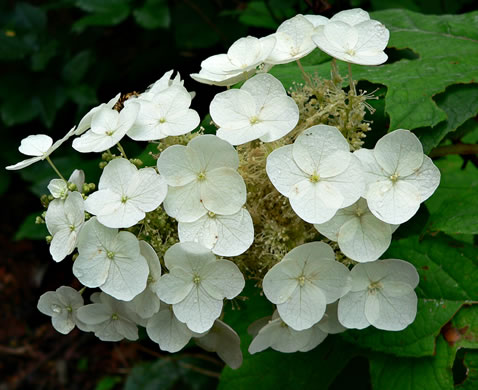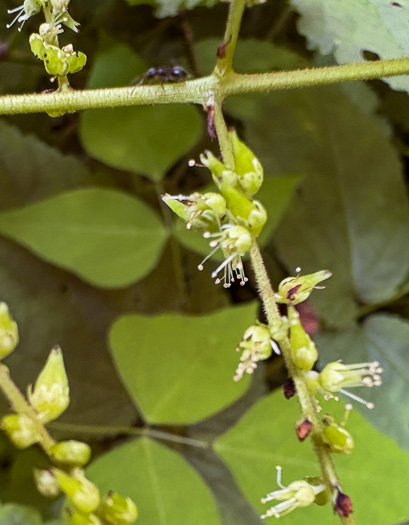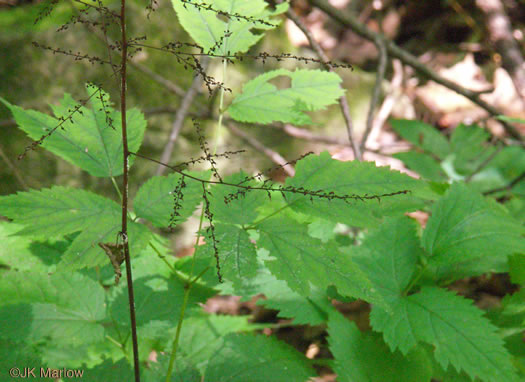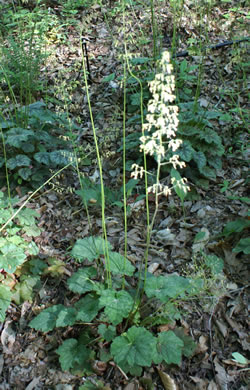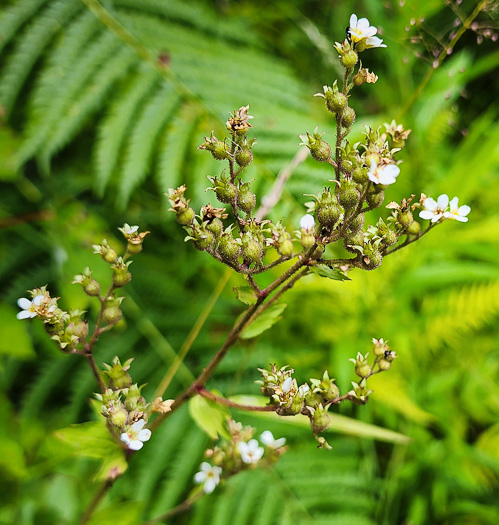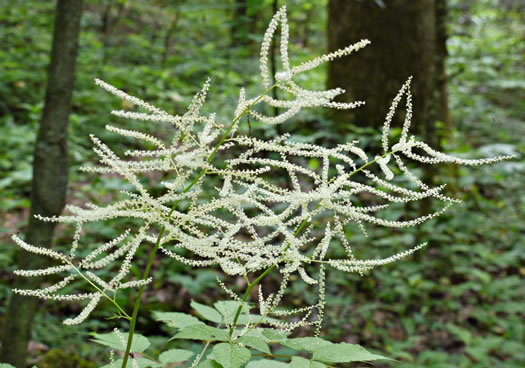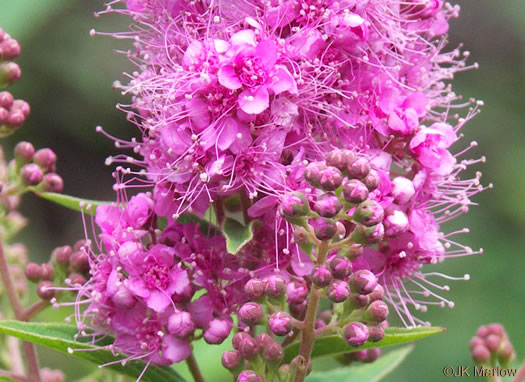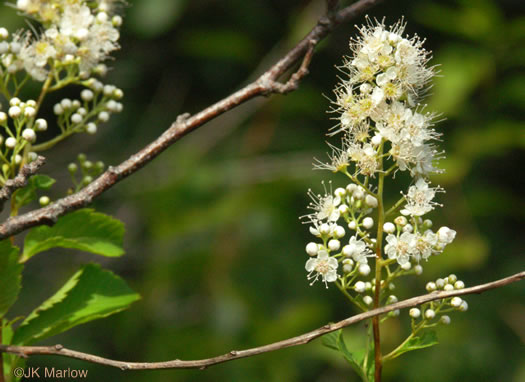Your search found 238 image(s) illustrating the term "panicle." For a written explanation, click on "panicle" in the Glossary.
To see larger pictures, click or hover over the thumbnails.
To go to the plant's detail page, click its name.
 Starved Witchgrass,
Dichanthelium depauperatum
Starved Witchgrass,
Dichanthelium depauperatum
Panicle usually not much exceeding leaves, per Manual of the Grasses of the United States (Hitchcock & Chase, 1950).
 Open-flower Witchgrass,
Dichanthelium laxiflorum
Open-flower Witchgrass,
Dichanthelium laxiflorum
Early panicles 4-9cm long, later panicles partly hidden in leaf sheaths, per Forest Plants of the Southeast and Their Wildlife Uses (Miller & Miller, 2005).
 Open-flower Witchgrass,
Dichanthelium laxiflorum
Open-flower Witchgrass,
Dichanthelium laxiflorum
Autumnal blades scarcely reduced, much exceeding the secondary panicles, per Manual of the Grasses of the United States (Hitchcock & Chase, 1950).
 Nerved Witchgrass,
Dichanthelium neuranthum
Nerved Witchgrass,
Dichanthelium neuranthum
Vernal panicle branches strongly ascending to erect; spikelets 1.8-2.2mm long, per Weakley's Flora.
 Ravenel's Witchgrass,
Dichanthelium ravenelii
Ravenel's Witchgrass,
Dichanthelium ravenelii
Panicle 7-12cm long. Spikelets 4-4.3mm, sparsely papillose-pubescent, per Manual of the Grasses of the United States (Hitchcock & Chase, 1950).
 Woolly Witchgrass,
Dichanthelium acuminatum var. acuminatum
Woolly Witchgrass,
Dichanthelium acuminatum var. acuminatum
Panicle 2-10cm long, branches scaberulous. Spikelets 1.4-2.2mm long, per Vascular Flora of the Carolinas (Radford, Ahles, & Bell, 1968).
 Blue Witchgrass,
Dichanthelium caerulescens
Blue Witchgrass,
Dichanthelium caerulescens
Vernal panicle 3-7cm long; spikelets obovoid, turgid, glabrous, per Manual of the Grasses of the United States (Hitchcock & Chase, 1950).
 Blue Witchgrass,
Dichanthelium caerulescens
Blue Witchgrass,
Dichanthelium caerulescens
Mature vernal panicles usually short-exserted with ascending branches, per Weakley's Flora (2015).
 Long-ligule Witchgrass,
Dichanthelium longiligulatum
Long-ligule Witchgrass,
Dichanthelium longiligulatum
Panicle 3-8cm long, branches spreading to ascending. Spikelets 1.2-1.5mm, per Vascular Flora of the Carolinas (Radford, Ahles, & Bell, 1968).
 Erectleaf Witchgrass,
Dichanthelium erectifolium
Erectleaf Witchgrass,
Dichanthelium erectifolium
Panicle rather narrow, densely flowered; spikelets nearly spherical, per Manual of the Grasses of the United States (Hitchcock & Chase, 1950).
 Round-fruited Witchgrass,
Dichanthelium sphaerocarpon
Round-fruited Witchgrass,
Dichanthelium sphaerocarpon
Panicle 4-13cm long, branches spreading-ascending. Spikelets 1.4-1.6mm, per Vascular Flora of the Carolinas (Radford, Ahles, & Bell, 1968).
 Many-flowered Witchgrass,
Dichanthelium polyanthes
Many-flowered Witchgrass,
Dichanthelium polyanthes
Panicle longer than broad, conspicuously many-flowered, per The Grasses of North Carolina (Blomquist, 1948).
 Many-flowered Witchgrass,
Dichanthelium polyanthes
Many-flowered Witchgrass,
Dichanthelium polyanthes
Panicle 5-20cm long. Spikelets 1.2-1.6mm, per Vascular Flora of the Carolinas (Radford, Ahles, & Bell, 1968).
 Velvet Witchgrass,
Dichanthelium scoparium
Velvet Witchgrass,
Dichanthelium scoparium
Panicle's rachis villous, the branches spreading-ascending, villous, spotted, per Vascular Flora of the Carolinas (Radford, Ahles, & Bell, 1968).
 Velvet Witchgrass,
Dichanthelium scoparium
Velvet Witchgrass,
Dichanthelium scoparium
Panicle 6-16cm long, 5-10cm broad, per Vascular Flora of the Carolinas (Radford, Ahles, & Bell, 1968).
 Variable Witchgrass,
Dichanthelium commutatum +
Variable Witchgrass,
Dichanthelium commutatum +
Panicle 6-12 cm long, per Manual of the Grasses of the United States (Hitchcock & Chase, 1950).
 Deer-tongue Witchgrass,
Dichanthelium clandestinum
Deer-tongue Witchgrass,
Dichanthelium clandestinum
Seed from reduced panicles of summer-fall cleistogamous flowers in leaf sheath
 Bosc's Witchgrass,
Dichanthelium boscii
Bosc's Witchgrass,
Dichanthelium boscii
Panicle 6-12cm long, spikelets 4-4.5mm long, about half as wide, per Manual of the Grasses of the United States (Hitchcock & Chase, 1950).
 Chinese Silvergrass,
Miscanthus sinensis
Chinese Silvergrass,
Miscanthus sinensis
Panicles dense, branches and pedicels ascending, per Vascular Flora of the Carolinas (Radford, Ahles, & Bell, 1968).
 Chinese Silvergrass,
Miscanthus sinensis
Chinese Silvergrass,
Miscanthus sinensis
Panicle somewhat fan-shaped, of silky aggregate racemes 10-20cm long, per Manual of the Grasses of the United States (Hitchcock & Chase, 1950).
 Silver Plumegrass,
Erianthus alopecuroides
Silver Plumegrass,
Erianthus alopecuroides
Panicle 20-30cm long, branches ascending or spreading, per Forest Plants of the Southeast and Their Wildlife Uses (Miller & Miller, 2005).
 Narrow Plumegrass,
Erianthus strictus
Narrow Plumegrass,
Erianthus strictus
Panicle usually 1-3cm broad, the branches closely appressed, per Weakley's Flora (2015).
 Sugarcane Plumegrass,
Erianthus giganteus
Sugarcane Plumegrass,
Erianthus giganteus
Panicle silvery to purplish, 15-40cm long, 8-15cm broad, per Vascular Flora of the Carolinas (Radford, Ahles, & Bell, 1968).
 Hairy Jointgrass,
Arthraxon hispidus var. hispidus
Hairy Jointgrass,
Arthraxon hispidus var. hispidus
Panicles of few to several racemes, flabellate, on filiform peduncles, per Manual of the Grasses of the United States (Hitchcock & Chase, 1950).
 Johnsongrass,
Sorghum halepense
Johnsongrass,
Sorghum halepense
Open spreading panicle 15-50cm long, w numerous whorled projecting branches, per Forest Plants of the Southeast and Their Wildlife Uses (Miller & Miller, 2005).
 Johnsongrass,
Sorghum halepense
Johnsongrass,
Sorghum halepense
Its panicle has a reddish color a little different from any other grass, per All About Weeds (Spencer, 1940).
 Lopsided Indiangrass,
Sorghastrum secundum
Lopsided Indiangrass,
Sorghastrum secundum
Panicle 20-40cm long, one-sided, the branches mostly in separated fascicles, per Manual of the Grasses of the United States (Hitchcock & Chase, 1950).
 Elliot's Indiangrass,
Sorghastrum elliottii
Elliot's Indiangrass,
Sorghastrum elliottii
Panicle loose, nodding at apex, the filiform branchlets flexuous, per Manual of the Grasses of the United States (Hitchcock & Chase, 1950).
 Sawgrass,
Cladium jamaicense
Sawgrass,
Cladium jamaicense
Inflorescence a narrow panicle 3-9dm long, per Weakley's Flora (2015).
 Sawgrass,
Cladium jamaicense
Sawgrass,
Cladium jamaicense
Panicle branches bearing several fascicles of spikelets, per Weakley's Flora (2015).
 Heartleaf Pickerelweed,
Pontederia cordata var. cordata
Heartleaf Pickerelweed,
Pontederia cordata var. cordata
Inflorescence a dense terminal spike-like panicle, per Wildflowers of Tennessee, the Ohio Valley, and the Southern Appalachians (Horn, Cathcart, Hemmerly, & Duhl, 2005).
 Tapertip Rush,
Juncus acuminatus
Tapertip Rush,
Juncus acuminatus
Inflorescences are terminal panicles of 5-50 heads, with branches ascending, per Flora of North America.
 False Solomon's Seal,
Maianthemum racemosum
False Solomon's Seal,
Maianthemum racemosum
Numerous flowers in a dense terminal panicle 2-6" long, per Wildflowers of Tennessee, the Ohio Valley, and the Southern Appalachians (Horn, Cathcart, Hemmerly, & Duhl, 2005).
 Pinebarrens Death-camas,
Stenanthium leimanthoides
Pinebarrens Death-camas,
Stenanthium leimanthoides
Flowers in a dense panicle tipped with a 3-4" raceme, per Wildflowers of Tennessee, the Ohio Valley, and the Southern Appalachians (Horn, Cathcart, Hemmerly, & Duhl, 2005).
 Featherbells,
Stenanthium gramineum var. gramineum
Featherbells,
Stenanthium gramineum var. gramineum
Smooth herb arising from a slender bulb, to 5' tall, with a 1-3' panicle, per Atlantic Coastal Plain Wildflowers (Nelson, 2006).
 Featherbells,
Stenanthium gramineum var. gramineum
Featherbells,
Stenanthium gramineum var. gramineum
A branching 1-3' inflorescence (technically a panicle) tops the stem, per Atlantic Coastal Plain Wildflowers (Nelson, 2006).
 Bog Featherbells,
Stenanthium gramineum var. robustum
Bog Featherbells,
Stenanthium gramineum var. robustum
Panicle plume-like, per Manual of the Southeastern Flora (JK Small, 1933).
 Common Wild Yam,
Dioscorea villosa
Common Wild Yam,
Dioscorea villosa
Staminate inflorescence a single panicle in each axil (of median or upper leaves), per Weakley's Flora (2020).
 Japanese Hops,
Humulus scandens
Japanese Hops,
Humulus scandens
Staminate inflorescences axillary and terminal, erect, cymose panicles, per Flora of North America.
 Canada Wood-nettle,
Laportea canadensis
Canada Wood-nettle,
Laportea canadensis
Flowers in terminal & axillary panicles: the upper female, lower male, per Guide to the Wildflowers of SC, 1st ed. (Porcher & Rayner, 2001).
 West Indian Wood-nettle,
Laportea aestuans
West Indian Wood-nettle,
Laportea aestuans
Staminate & pistillate flwrs in same panicle, or proximal panicles staminate, per Flora of North America.
 Greenfruit Clearweed,
Pilea pumila
Greenfruit Clearweed,
Pilea pumila
Staminate and pistillate flowers in mixed, axillary, 1-sided panicles, per Vascular Flora of the Carolinas (Radford, Ahles, & Bell, 1968).
 Curly Dock,
Rumex crispus ssp. crispus
Curly Dock,
Rumex crispus ssp. crispus
Panicle composed of clusters of staminate and pistillate flowers, per Vascular Flora of the Carolinas (Radford, Ahles, & Bell, 1968).
 Giant Knotweed,
Reynoutria sachalinensis
Giant Knotweed,
Reynoutria sachalinensis
Inflorescences axillary, mostly distal, erect or spreading, paniclelike, per Flora of North America.
 Himalayan Knotweed,
Koenigia polystachya
Himalayan Knotweed,
Koenigia polystachya
Inflorescences paniclelike, mostly terminal and sometimes also axillary, per Flora of North America.
 Starry Campion,
Silene stellata
Starry Campion,
Silene stellata
Panicle open, elongate; pedicels glabrous or puberulent, per Vascular Flora of the Carolinas (Radford, Ahles, & Bell, 1968).
 Mountain Catchfly,
Silene ovata
Mountain Catchfly,
Silene ovata
Flowers in panicle-like terminal clusters, per Wildflowers of the Atlantic Southeast (Cotterman, Waitt, & Weakley, 2019).
 Appalachian Meadowrue,
Thalictrum coriaceum
Appalachian Meadowrue,
Thalictrum coriaceum
Flowers in a loose, widely branched, pyramid-shaped panicle on separate male and female plants, per Wildflowers of the Atlantic Southeast (Cotterman, Waitt, & Weakley, 2019).
 Skunk Meadowrue,
Thalictrum amphibolum
Skunk Meadowrue,
Thalictrum amphibolum
Flowers many, on elongate racemes or panicles, per Wildflowers in the Field and Forest: Northeastern US (Clemants & Gracie, 2006).
 Carolina Moonseed,
Nephroia carolina
Carolina Moonseed,
Nephroia carolina
Staminate panicle to 15cm long, pistillate much shorter, per Vascular Flora of the Carolinas (Radford, Ahles, & Bell, 1968).
 Moonseed,
Menispermum canadense
Moonseed,
Menispermum canadense
Panicles axillary, to 15cm long, loose. Flowers 4mm wide, per Native Shrubs and Woody Vines of the Southeast (Foote & Jones, 1989).
 Pale Corydalis,
Capnoides sempervirens
Pale Corydalis,
Capnoides sempervirens
Flowers in a terminal raceme or panicle, per Wildflowers of the Eastern United States (Duncan & Duncan, 1999).
 Oakleaf Hydrangea,
Hydrangea quercifolia
Oakleaf Hydrangea,
Hydrangea quercifolia
Inflorescence a panicle, more than 20 large sterile flowers borne throughout, per Weakley's Flora.
 Appalachian False Goatsbeard,
Astilbe biternata
Appalachian False Goatsbeard,
Astilbe biternata
Panicle branches glandular-puberulent. Flowers bracteate, short-pedicellate. Stamens 8-10, per Vascular Flora of the Carolinas (Radford, Ahles, & Bell, 1968).
 Appalachian False Goatsbeard,
Astilbe biternata
Appalachian False Goatsbeard,
Astilbe biternata
Fruit erect, lanceolate follicles, 0.15-.2" long, borne on a large panicle, per Wildflowers of Tennessee, the Ohio Valley, and the Southern Appalachians (Horn, Cathcart, Hemmerly, & Duhl, 2005).
 American Alumroot,
Heuchera americana
American Alumroot,
Heuchera americana
The inflorescence is a pedunculate panicle, per Vascular Flora of the Carolinas (Radford, Ahles, & Bell, 1968).
 Brook-saxifrage,
Boykinia aconitifolia
Brook-saxifrage,
Boykinia aconitifolia
Panicle compact at anthesis, spreading in fruit, per Vascular Flora of the Carolinas (Radford, Ahles, & Bell, 1968).
 Eastern Goatsbeard,
Aruncus dioicus var. dioicus
Eastern Goatsbeard,
Aruncus dioicus var. dioicus
Inflorescence a large panicle of racemes, per Vascular Flora of the Carolinas (Radford, Ahles, & Bell, 1968).
 Narrowleaf Meadowsweet,
Spiraea alba
Narrowleaf Meadowsweet,
Spiraea alba
Inflorescence a much-branched panicle, its branches canescent, per Vascular Flora of the Carolinas (Radford, Ahles, & Bell, 1968).
 Broadleaf Meadowsweet,
Spiraea latifolia
Broadleaf Meadowsweet,
Spiraea latifolia
Inflorescence a much-branched panicle, its branches glabrous, per Vascular Flora of the Carolinas (Radford, Ahles, & Bell, 1968).

